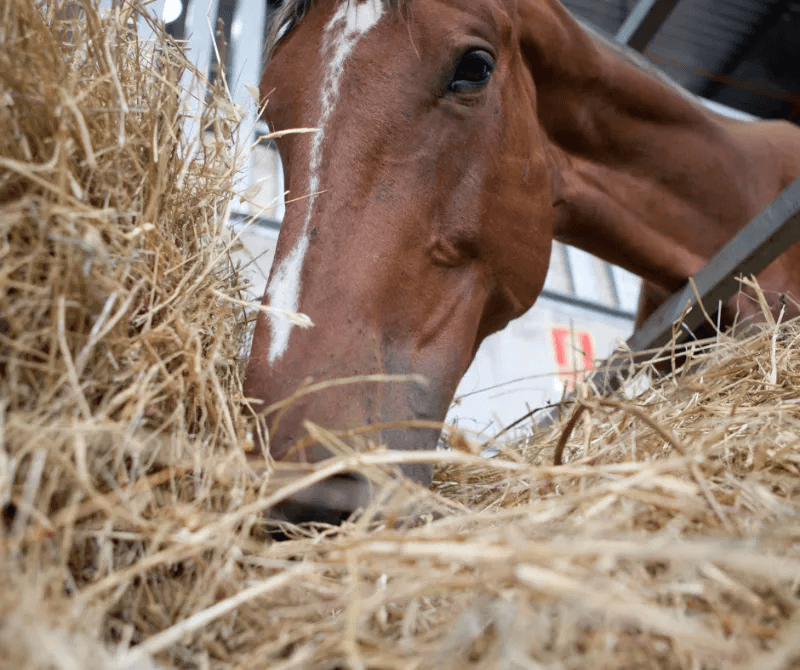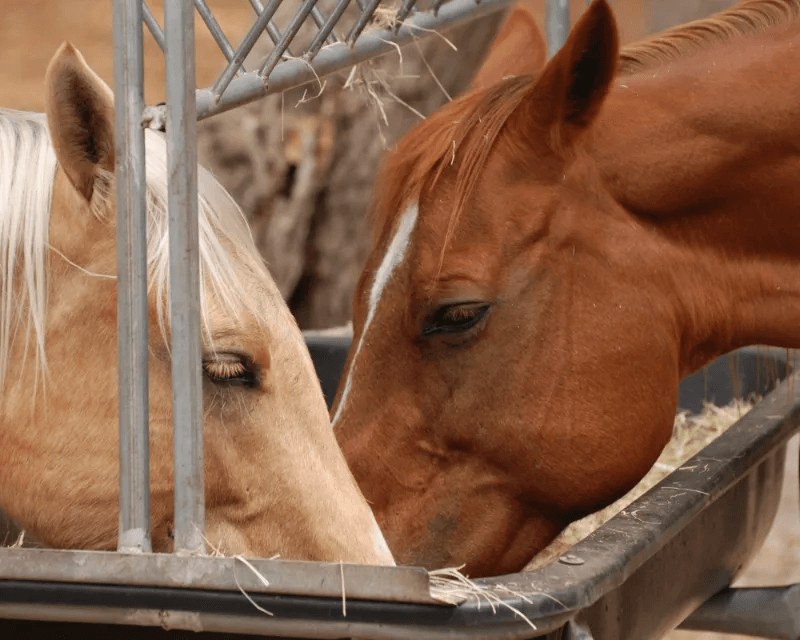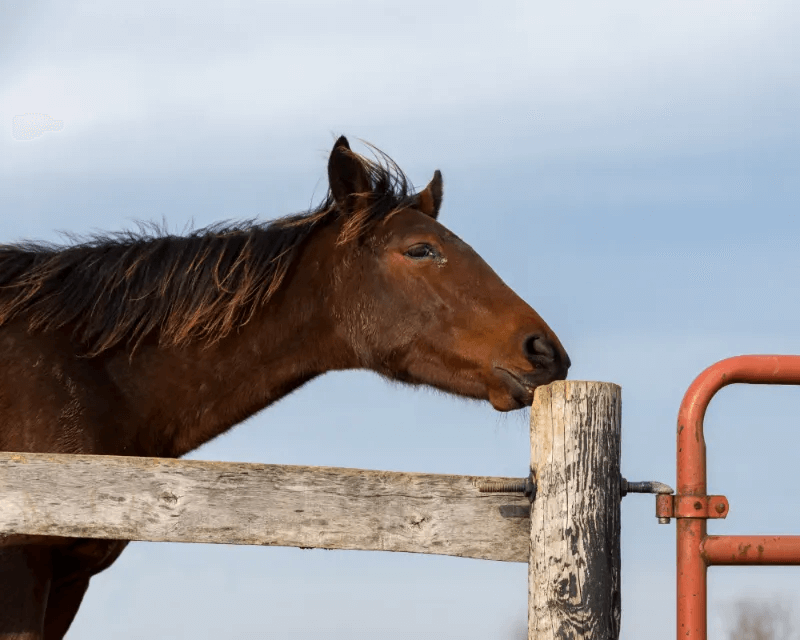Horse barn safety comes down to the small details that make a stable a success story. Cutting corners can be both costly and dangerous to the health and welfare of your horses and the people who work with them.
Here are some tips on how hay racks, feed troughs, and chew guards should be installed and maintained for maximum safety.
What are Horse Hayracks?

The overall health of horses depends heavily on hay – their primary source of fiber. Hay management promotes longevity and robust health for horses by ensuring the digestive system functions as nature intended. Proper hay management also affects a horse’s behavior, as it helps to reduce digestive issues as well as stress. High-quality hay is essential to maintaining a healthy horse.
When hay is carelessly strewn on the ground, it becomes susceptible to contamination from dirt, dust, and even waste. This not only results in unnecessary wastage but also exposes the horse to a slew of potential health complications. Therefore, it’s important to store hay in a clean, dry place away from the horse’s living area.
Horse hayracks, with their elevated design, solve this challenge. By keeping the hay off the ground, they substantially reduce the risk of contamination. This ensures that the horses are ingesting clean, quality hay whenever they need it.
Furthermore, hayracks that are placed at the right height mimic horses’ natural grazing postures. This alignment is more than ergonomic; if it’s positioned correctly, it can also improve respiratory health, streamlining the feeding process for stable managers and owners.
Poor Construction Dangers
Risk of Entanglement and Entrapment
If a hayrack is built with gaps or spaces that are too large, a horse can easily get its hoof, head, or other body parts trapped. This can result in sprains, broken bones, or even strangulation if the horse panics and cannot free itself.
To avoid this, hayracks should be designed and built according to the size and shape of the horse, and they should be regularly inspected for signs of damage or wear.
Sharp Edges and Protrusions
Improperly finished horse hayracks might have sharp edges or protruding parts. Horses reaching for hay can cut or scrape themselves on these edges, leading to wounds that might become infected. To avoid this, hayracks should be designed with smooth edges and surfaces.
Unstable Mountings
An improperly secured hayrack can pose significant risks. If it collapses under the weight of hay or due to a horse leaning or pushing against it, the horse could sustain injuries. Additionally, spilled hay may lead to unnecessary waste and create a messy environment that attracts pests.
Consumption Difficulties
A poorly designed hayrack might make it challenging for the horse to access its hay, causing frustration and potentially leading to malnourishment if the horse cannot get adequate food. Additionally, if hay falls out too easily, it can lead to excessive wastage.
Material Hazards
Using inappropriate or substandard materials for hayrack construction can introduce risks. For instance, certain metals might rust (leading to jagged edges) or could even be toxic if ingested in small amounts over time. Similarly, using untreated wood might expose the horse to splinters or harmful chemicals.
What are Horse Feed Troughs?

The act of feeding, while seemingly simple, has nuances that can significantly impact the health and well-being of horses. Orderly feeding is crucial to ensure that horses receive the nourishment they require without excess waste or exposure to contaminants.
Horse feed troughs are fundamental in establishing this order. These robust structures serve as designated containers for horse feed, ensuring that every horse gets its allotted ration. Without a proper trough, feed can scatter, leading to wastage and attracting pests, which can introduce a myriad of health risks to the stable environment.
Additionally, specialized feed troughs are designed to regulate the horse’s rate of consumption. This is crucial because horses that eat rapidly are at a higher risk of digestive complications, like colic. By slowing down their eating pace, these troughs aid in better digestion and nutrient absorption, further underscoring their importance in a stable’s daily operations.
Poor Construction Dangers
Risk of Injury
Troughs with wide gaps, protruding parts, or loose fittings can pose a risk of injury. Horses can get their hooves, heads, or halters caught, leading to potential injuries, panic, or strangulation.
Sharp Edges and Protrusions
Just like with hayracks, poorly constructed feed troughs might have sharp edges or parts sticking out. Horses – especially enthusiastic eaters – might cut or bruise themselves when trying to reach for their feed.
Unstable Positioning
Horse feed troughs that aren’t sturdily built or securely anchored can be easily tipped or displaced by horses, leading to spilled feed, unnecessary waste, and potential injuries — especially if the trough is heavy or becomes a tripping hazard.
Material Concerns
Metal troughs can rust or become very hot or cold, depending on the weather, posing risks to the horse. On the other hand, plastic troughs can break down or become brittle over time, potentially leading to the ingestion of plastic fragments.
Bacterial and Fungal Growth
Poorly designed or cleaned troughs can accumulate moisture, leftover feed, or debris. This can be a breeding ground for bacteria or fungi. When ingested, this can lead to various health issues for the horse, including colic or other digestive problems.
Contamination Risks
A trough that’s too low or too open might allow pests (like rodents or birds) to access the feed. Moreover, if positioned in a place where other animals can access it, there’s a risk of feed being contaminated by other species, potentially leading to diseases or ingestion of harmful substances.
Choking Hazards
If the trough’s design encourages rapid eating or doesn’t allow for the even distribution of feed, horses might gulp down their food too quickly, increasing the risk of choking.
Learn how to improve the health, welfare, and happiness of stabled horses.
What are Horse Chew Guards?

Horses that chew or crib can cause significant damage to wooden fences, barn doors, and stalls. This not only leads to ongoing repair and replacement costs but can compromise the safety and integrity of these structures. Apart from the obvious wear and tear on the stable’s infrastructure, consistent chewing or cribbing can jeopardize the safety of both the horse and handlers.
Horse chew guards, strategically placed on surfaces prone to being chewed, act as the first line of defense for these surfaces. By offering a protective barrier, they not only prevent infrastructural damage but also deter horses from ingesting potentially harmful materials, like toxic chemicals, preservatives, or paint chips.
While chew guards will do little to prevent the act of cribbing or wind-sucking (when a horse grips a solid object with its incisors and pulls backwards, taking in the air), chew guards make it difficult for horses to get a grip on surfaces. This deters the negative effects of the behavior, such as wearing down a horse’s incisors prematurely, affecting the horse’s bite and the horse’s ability to chew food properly.
To ensure the safety and well-being of horses, it’s crucial to invest in high-quality, well-designed chew guards that are specifically made for horses.
Poor Construction Dangers
Injury to the Horse
If a chew guard has sharp edges, splinters, or protruding hardware, it can lead to scrapes, cuts, or more severe injuries to the horse’s mouth, face, or gums.
Ineffective Deterrence
A horse chew guard that isn’t durable might not stand up to a determined horse. If the horse can easily break or dislodge the guard, it will not serve its purpose, allowing the horse to continue its damaging behaviors.
Ingestion Hazards
Low-quality materials or those with toxic treatments can pose a risk if the horse manages to chew on or ingest pieces of the guard itself. This could lead to internal obstructions or poisoning.
Potential for Choking
If parts of a poorly constructed chew guard can be broken off or dislodged, they could become a choking hazard for the horse.
Increased Stress or Anxiety
A poorly designed chew guard might not only fail to deter cribbing but could also cause frustration or stress for a horse that tries to engage in its habitual behavior, potentially leading to other harmful or aggressive behaviors.
Economic Implications
In the long run, investing in low-quality chew guards can lead to higher expenses. Frequent replacements, repairs to the structures they should protect, and potential veterinary bills from horse injuries or ingestion of guard materials can quickly add up.
Aesthetic Issues
Poorly made or ill-fitting chew guards can be unsightly, detracting from the overall appearance of the barn, stall, or fencing. Over time, they might also discolor or damage the surfaces they’re attached to.
Reinforced Undesirable Behavior
If a chew guard doesn’t deter a horse effectively, it can inadvertently reinforce the cribbing or chewing behavior, making it even harder to manage in the future.
Additional Safety Features to Consider
- Ventilation systems
- Fire safety measures
- Slip-resistant flooring
- Proper lighting
- Safe horse stall design
- Emergency exits
Ensuring Horse Barn Safety with Helpful Accessories
The design and construction of hayracks, chew guards, and feed troughs in horse housing is important for the safety, comfort, and health of these animals.
J&E Grill Manufacturing is a trusted provider of durable, high-quality horse housing accessories designed with safety and longevity in mind. Our products are crafted to address common concerns, ensuring your horses are protected and comfortable. Contact us for more information on how to create a safe and secure environment for your horse.